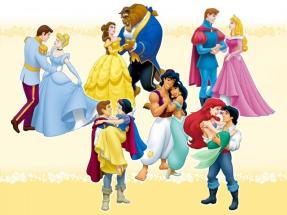Romantic myths are beliefs, which due to their social and historical construction are considered as absolute and true truths. These myths have a great influence on the daily life of affective and interpersonal relationships. They are resistant to change ad reasoning, because there is a total internalization of these by society. These establish what is acceptable and «ordinary».
Romantic myths are fictitious, absurd, irrational and impossible and tend to cause negative results and consequences for people.
According to Yela (2003) the main romantic myths are the myth of the «half orange», the myth of pairing, the myth of exclusivity, the myth of fidelity, the myth of jealousy, the myth of equivalence, the myth of omnipotence, the myth of free will, the myth of marriage and the myth of eternal passion.
All the mentionated myths above can be divided into five differents groups.
The first consists of myths about romantic love as the only source of happiness. The first myth in composing this group is the myth of pairing or of the couple, which is based on the consideration of the heterosexual and monogamous couple as a natural and universal rule. The second component of this first group is the myth of marriage or coexistence, based on the idea that love should lead to the stable union of the couple and become the only basis of their coexistence. These myths can be seen reflected in the classic Disney’s stories and films, where the female and male characters are destined to meet, marry, be happy and eat partridges.

The second great group are those myths about the negation of reality. This is composed in the first place by the myth of the «half orange», which consists of the existence of a person predestined to be with another, being this the only possible choice. It has its origin in the Aristophanes’s story about the twin souls. The internalization of this myth causes a high level of demand in the couple’s relationship with the consequent feelings of disappointment or excessive tolerance. The myth of free will or belief that external factors (socio-biological-cultural) don’t influence the feelings of love, can cause negative consequences such as overconfidence or blame.
The third group consists of the myth of omnipotence or belief that if love is indeed external or internal obstacles don’t influence feelings of a loving nature. The internalization of this myth has as consequences the use of this as an excuse for the non-modification of toxic behaviours or attitudes.

The fourth group is called myths about exclusivity. The myth of exclusivity is the belief in the existence of a single love, that is, the impossibility of being in love with two people at once. The myth of fidelity is based on the consideration that all passionate, erotic and romantic desires must be directed and satisfied by the couple themselves. People who «deviate» or leave these rules are highly objective subjects of serious internal, relational and social conflicts. The myth of equivalence consists in the equating and fusion of «love» (feeling) and «falling in love» (a more or less lasting state). This belief can have dire and traumatic consequences for the individual. The infatuation, as a psychological process is changing, being therefore impossible to consider that a person doesn’t love another if he isn’t passionately in love.
And finally, the myths about control, shaped mainly by the myth of jealousy, which is the reason for selfish, unjust and repressive behavior, based on the belief of jealousy as an indispensable requirement of true love. It’s usually represented through phrases such as «who doesn’t have jealousy doesn’t love» or «if my partner is jealous it’s because he loves me». This myth has a close relationship with two of those discussed above, the myth of exclusivity and the myth of fidelity.
The influence of these beliefs, myths and ideals through popular cultural and the media provokes the appearance and perpetuation of gender stereotypes and sexist attitudes. These beliefs implant a model of affective relationship where true love is closely related to suffering, difficulties and their overcoming as proof and example of love, and to the renunciation of one’s individuality as a person. The myths of romantic love make it impossible for young people to understand more realistic models of love. According to the study conducted by the Ministry of Equality and the Complutense University of Madrid with the aim of providing a diagnosis of the current situation to prevent gender-based violence in adolescence, the average age of beginning of relationships is 13 years, that is why prevention and treatment in adolescence is key. The way in which adolescents understand what love and relationships are, are based on the values and beliefs in which they have been educated and socialized, not in their own scarce and fragmented experience (Amurrio, 2010). Education in classrooms is essential in the prevention of gender violence. Educational institutions are the second socializing group of individuals and, therefore, the main transmitters of values after the family itself. The need for the existence of a primary prevention in adolescence lies in the fact that in this stage the bases for socialization and romantic interaction in the adult stage are established. Studies indicate that adolescent women victims of gender violence tend to victimize in adulthood (Smith el Al., 2003). and that adolescent males related to experiences of violence tend to repeat and perpetuate these experiences in adulthood (White and Smith, 2004). The constant revaluation and reflection on the values and principles that are transmitted and developed in the educational process is necessary for the construction of an egalitarian society.
Bibliography.
Amurrio, M., Larrinaga, A., Usategui, E. y Del Valle, A. (2010). Violencia de género en las relaciones de pareja de adolescentes y jóvenes de Bilbao (Gender violence in dating relationships of adolescents and young from Bilbao). Zerbitzuan, 47, 121-134.
Smith, P.H., White, J.W. y Holland, L. (2003). A longitudinal perspective on dating violence among adolescent and college-age women. American Journal Of Public Health, 93, 104-110.
White, J.W. y Smith, P.H. (2004). Sexual assault perpetration and reperpetration: from adolescence to young adulthood. Criminal, Justice and Behavior, 31 (2), 182-202.
Yela, C. (2003). La otra cara del amor: mitos, paradojas y problemas. Encuentros en Psicología Social, 1(2), 263-267.








Creo que es una buena redacción sobre lo que son los mitos de amor romántico, en el que se nos presenta diferentes ejemplos como pueden ser películas o anuncios que nos muestran que el amor todo lo puede o que los celos son buenos pero que en realidad todo es un amor idealizado que nos meten en la cabeza la sociedad desde que somos pequeños.
Me gustaLe gusta a 2 personas
Me parece interesante que hayáis utilizado películas y dibujos disney como mitos del amor romántico, lo encuentro muy original con idea de concienciar a la gente de que hemos estado engañados por una publicidad machista incluso delante de nuestros propios ojos y meternos en la cabeza de que las mujeres tienen que ser rescatadas por un hombre.
Veo perfecto que utilicéis el ingles como medio de escritura, pero a al vez opino que lo podríais haber puesto también en español para facilitar así la compresión de quienes no saben ingles.
Me gustaMe gusta
Hay otra entrada con el mismo texto en español.
Me gustaMe gusta